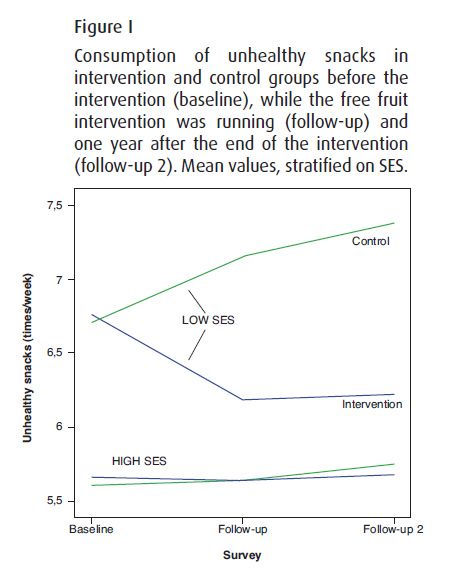Free school fruit in Norway – decreased consumption of unhealthy snacks
Children in Norway eat too little fruit and vegetables, and they eat too much unhealthy snacks. The national Norwegian authorities have made a considerable effort to increase school children’s fruit and vegetable intake at school. A subscription program for grades 1-10 was initiated in 1996 and made nation-wide in 2003 in collaboration with the Norwegian Marketing Board for Fruits and Vegetables. In this program the schools initially choose to participate or not, and then the pupils at the participating schools can decide to subscribe or not. The cost for the parents is currently NOK 2.50 per school day (approximately EUR 0.30). The pupils who subscribe receive a piece of fruit or a carrot each school day, usually in connection with their lunch meal. The program is subsidized by the Norwegian Government with NOK 1.00 per pupil per school day.
The subscription program, and a free pilot version of the same program (without parental payment), were evaluated in the research project Fruits and Vegetables Make the Marks (FVMM). In a school randomized trial including 38 schools, a cohort of 1,950 pupils (initially in 6th and 7th grades) was followed from school year 2001-02 to school year 2004-05. The results reported were that both programs increased FV intake, but that the free program was much more effective than the subscription programme (effect sizes were 0.9 and 0.2 portions/day on FV intake at school, respectively, compared to control schools)1, and that one year of free school fruit also had a positive long term effect on adolescents’ FV intake both one2 and three3 years after the end of the free fruit intervention (effect sizes were about 0.5 and 0.4 portions/day, respectively, compared to control schools).
Interesting effects of the free school fruit program were also seen on consumption of unhealthy snacks (scale of soft drinks, candy and potato chips). The free fruit program resulted in a decreased consumption of unhealthy snacks measured both while the programme was running1 and one year after the end of the intervention4. An interaction between socio economic status (SES, indicated by parental college/university education or not) and the intervention was found, and an effect of the intervention on unhealthy snacks were only seen among low SES pupils; effect size was 1.0 times/week while the program was running and 1.2 times/week a year later (Figure I). Low SES pupils also consumed considerably more unhealthy snacks than high SES pupils at baseline (Figure I). Also three years after the end of the intervention, the intervention group ate less unhealthy snacks than the control group3, however, the difference was not statistically significant.
From fall 2007, an official free school fruit program (without parental payment) was implemented in all secondary Elementary schools (grades 8-10) and all combined schools (grades 1-10) in Norway. A new repeated cross-sectional survey at the same schools was conducted within the FVMM project in 2008, making it possible to evaluate the effect of this nation-wide implementation of the free school fruit program.
The increase in fruit intake from 2001 to 2008 at schools taking part in the official school fruit program from 2007 (i.e. schools with grades 1-10) was much greater than at schools not getting free fruit (i.e. schools with grades 1-7) (effect size was 0.74 portions/day)5. No effect was observed for vegetable intake. However, again a decrease in consumption of unhealthy snacks was observed at the schools enrolling in the free fruit program, compared to the control schools, and again it was only observed among children of parents without higher education (unpublished data).
In conclusion, these evaluations of free school fruit in Norway clearly indicates that increased intake of fruits decreased the consumption of unhealthy snacks; at least for low SES children with a high consumption of unhealthy snacks (i.e. those that need it the most).

References
- Bere E, Veierød M, Klepp K-I. The Norwegian School Fruit Programme: evaluating paid vs. no-cost subscriptions, Preventive Medicine 2005; 41:463-470.
- Bere E, Veierød MB, Bjelland M, Klepp K-I. Free school fruit – sustained effect one year later, Health Education Research, 2006, 21:268-275.
- Bere E, Veierød M, Skare Ø, Klepp K-I. Free school fruit – sustained effect three years later, International Journal of Behavioral Nutrition and Physical Activity, 2007, 4:5.
- Bere E, Klepp K-I. Free participation in the Norwegian School Fruit Programme: Increased fruit and vegetable intake gives decreased consumption of unhealthy snacks. International Conference, Health Benefits of Mediterranian-style diet (EGEA III), Rome, 2005.
- Bere E, Hilsen M, Klepp K-I. Effect of the nation wide free school fruit scheme in Norway, British Journal of Nutrition, 2010, 104:589-594.
